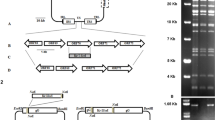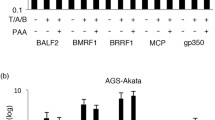Abstract
Equine herpesvirus type 1 (EHV-1) UL11 is a 74-amino-acid tegument protein encoded by ORF51 of the EHV-1 genome. EHV-1 UL11 was previously reported by other researchers using the RacL22 and RacH strains to be nonessential for viral replication in cultured cells. Here, we constructed UL11 mutant viruses including a UL11 null mutant and three C-terminal truncated mutants, for further characterization of EHV-1 UL11 using bacterial artificial chromosome (BAC) technology based on the neuropathogenic strain Ab4p. EHV-1 Ab4p UL11 was localized to juxtanuclear and Golgi regions as reported by other researchers. We found that no progeny viruses were produced by transfection of fetal equine kidney cells and rabbit kidney (RK-13) cells with the UL11 null mutant and truncation mutant BAC DNAs. However, mutant viruses were generated after transfection of RK13-UL11 cells constitutively expressing EHV-1 UL11 with the mutant BAC DNAs. In conclusion, UL11 of EHV-1 Ab4p is essential for replication in cultured cells.






Similar content being viewed by others
References
Andoh K, Kai K, Matsumura T, Maeda K (2009) Further development of an equine cell line that can be propagated over 100 times. J Equine Sci 20:11–14
Baines JD, Roizman B (1992) The UL11 gene of herpes simplex virus 1 encodes a function that facilitates nucleocapsid envelopment and egress from cells. J Virol 66:5168–5174
Baird NL, Yeh PC, Courtney RJ, Wills JW (2008) Sequences in the UL11 tegument protein of herpes simplex virus that control association with detergent-resistant membranes. Virology 374:315–321
Bowzard JB, Visalli RJ, Wilson CB, Loomis JS, Callahan EM, Courtney RJ, Wills JW (2000) Membrane targeting properties of a herpesvirus tegument protein-retrovirus gag chimera. J Virol 74:8692–8699
Britt WJ, Jarvis M, Seo J, Drummond D, Nelson J (2004) Rapid genetic engineering of human cytomegalovirus by using a lambda phage linear recombination system: demonstration that pp28 (UL99) is essential for production of infectious virus. J Virol 78:539–543
Chiu Y, Sugden B, Chang P, Chen L, Lin Y, Lan Y, Lai C, Liou J, Liu S, Hungb C (2012) Characterization and intracellular trafficking of Epstein-Barr Virus BBLF1, a protein involved in virion maturation. J Virol 86:9647–9655
del Rio T, DeCoste CJ, Enquist LW (2005) Actin is a component of the compensation mechanism in pseudorabies virus virions lacking the major tegument protein VP22. J Virol 79:8614–8619
Diefenbach RJ (2015) Conserved tegument protein complexes: essential components in the assembly of herpesviruses. Virus Res 210:308–317
Farnsworth A, Wisner TW, Johnson DC (2007) Cytoplasmic residues of herpes simplex virus glycoprotein gE required for secondary envelopment and binding of tegument proteins VP22 and UL11 to gE and gD. J Virol 81:319–331
Han J, Chadha P, Meckes DG Jr, Baird NL, Wills JW (2011) Interaction and interdependent packaging of tegument protein UL11 and glycoprotein E of herpes simplex virus. J Virol 85:9437–9446
Hubert PH, Birkenmaier S, Rziha H-J, Osterrieder N (1996) Alterations in the equine herpesvirus type-1 (EHV-1) strain RacH during attenuation. J Vet Med B 43:1–14
Kasem S, Yu MH, Yamada S, Kodaira A, Matsumura T, Tsujimura K, Madbouly H, Yamaguchi T, Ohya K, Fukushi H (2010) The ORF37 (UL24) is a neuropathogenicity determinant of equine herpesvirus 1 (EHV-1) in the mouse encephalitis model. Virology 400:259–270
Kelly BJ, Fraefel C, Cunningham AL, Diefenbach RJ (2009) Functional roles of the tegument proteins of herpes simplex virus type 1. Virus Res. 145:173–186
Kirisawa R, Kobayashi T, Uematsu R, Ikeda A, Kuroiwa R, Urakami A, Iwai H (2003) Growth of recombinant equine herpesvirus 1 (EHV-1) replaced with passage-induced mutant gene 1 and gene 71 derived from an attenuated EHV-1 in cell cultures and in the lungs of mice. Vet Microbiol 95:159–174
Kopp M, Granzow H, Fuchs W, Klupp BG, Mundt E, Karger A, Mettenleiter TC (2003) The pseudorabies virus UL11 protein is a virion component involved in secondary envelopment in the cytoplasm. J Virol 77:5339–5351
Loomis JS, Bowzard JB, Courtney RJ, Wills JW (2001) Intracellular trafficking of the UL11 tegument protein of herpes simplex virus type 1. J Virol 75:12209–12219
MacLean CA, Clark B, McGeoch DJ (1989) Gene UL11 of herpes simplex virus type 1 encodes a virion protein which is myristylated. J Gen Virol 70:3147–3157
Mettenleiter TC, Klupp BG, Granzow H (2009) Herpesvirus assembly: an update. Virus Res 143:222–234
Okada A, Izume S, Ohya K, Fukushi H (2015) Equine herpesvirus type 1 tegument protein VP22 is not essential for pathogenicity in a hamster model, but is required for efficient viral growth in cultured cells. J Vet Med Sci 77:1293–1297
Okada A, Kodaira A, Hanyu S, Izume S, Ohya K, Fukushi H (2014) Intracellular localization of equine herpesvirus type 1 tegument protein VP22. Virus Res 192:103–113
Owen DJ, Crump CM, Graham SC (2015) Tegument assembly and secondary envelopment of alphaherpesviruses. Viruses 7:5084–5114
Paillot R, Case R, Ross J, Newton R, Nugent J (2008) Equine herpes virus-1: virus, immunity and vaccines. Open Vet Sci J 2:68–91
Pomeranz LE, Blaho JA (2000) Assembly of infectious herpes simplex virus type 1 virions in the absence of full-length VP22. J Virol 74:10041–10054
Resh MD (1999) Fatty acylation of proteins: new insights into membrane targeting of myristoylated and palmitoylated proteins. Biochim Biophys Acta 1451:1–16
Sadaoka T, Yoshii H, Imazawa T, Yamanishi K, Mori Y (2007) Deletion in open reading frame 49 of varicella-zoster virus reduces virus growth in human malignant melanoma cells but not in human embryonic fibroblasts. J Virol 81:12654–12665
Sanchez V, Sztul E, Britt WJ (2000) Human cytomegalovirus pp28 (UL99) localizes to a cytoplasmic compartment which overlaps the endoplasmic reticulum-golgi-intermediate compartment. J Virol 74:3842–3851
Schimmer C, Neubauer A (2003) The equine herpesvirus 1 UL11 gene product localizes to the trans-golgi network and is involved in cell-to-cell spread. Virology 308:23–36
Silva MC, Yu Q, Enquist L, Shenk T (2003) Human cytomegalovirus UL99-encoded pp28 is required for the cytoplasmic envelopment of tegument-associated capsids. J Virol 77:10594–10605
Tanaka M, Kato A, Satoh Y, Ide T, Sagou K, Kimura K, Hasegawa H, Kawaguchi Y (2012) Herpes simplex virus 1 VP22 regulates translocation of multiple viral and cellular proteins and promotes neurovirulence. J Virol 86:5264–5277
Telford EAR, Watson MS, McBride K, Davison AJ (1992) The DNA sequence of equine herpesvirus-1. Virology 189:304–316
Tsujimura K, Shiose T, Yamanaka T, Nemoto M, Kondo T, Matsumura T (2009) Equine herpesvirus type 1 mutant defective in glycoprotein E gene as candidate vaccine strain. J Vet Med Sci 71:1439–1448
Tsujimura K, Yamanaka T, Kondo T, Fukushi H, Matsumura T (2006) Pathogenicity and immunogenicity of equine herpesvirus type 1 mutants defective in either gI or gE gene in murine and hamster models. J Vet Med Sci 68:1029–1038
Yu MH, Kasem S, Yoshizaki N, Pagamjav O, Yamaguchi T, Ohya K, Fukushi H (2012) Functional characterization of EUL47 in productive replication, morphogenesis and infectivity of equine herpesvirus 1. Virus Res 163:310–319
Acknowledgements
YB was supported by the Ministry of Higher Education in Egypt. We appreciate the technical support of Samy Kasem and Mohamed Nayel. This work was supported in part by a Grant-in-Aid for Scientific Research of the Ministry of Education, Culture, Sports, Science and Technology (MEXT) of Japan (KAKENHI no. 24380165 to HF).
Author information
Authors and Affiliations
Corresponding author
Additional information
Handling Editor: Diego G. Diel.
Rights and permissions
About this article
Cite this article
Badr, Y., Okada, A., Abo-Sakaya, R. et al. Equine herpesvirus type 1 ORF51 encoding UL11 as an essential gene for replication in cultured cells. Arch Virol 163, 599–607 (2018). https://doi.org/10.1007/s00705-017-3650-4
Received:
Accepted:
Published:
Issue Date:
DOI: https://doi.org/10.1007/s00705-017-3650-4




